Style is always a subjective concept, but throughout history certain styles are considered a no-go for certain people.
If you wanted to be thought of as a respectable lady before the modern era, there was no way you would have worn trousers.
If you were a man of social rank in western Europe in the seventeenth century, fabulous and elaborate wigs were a crucial and socially obligatory accessory, and to be seen without one would mean you had most likely lost status and fortune.
And these days, if you want to be taken seriously in the business world, whether as a man or woman, it is imperative that a suit be worn to all meetings, never casual wear like jeans or tennis shoes. Unless you are the CEO of a startup or Maximilian Büsser, then the opposite rule of course applies.
Yet in every one of these examples the rule is usually broken countless times by countless groups of people. So much so that a rule of style begins to look like just yet another opinion in a highly diversified world.
Women have worn pants throughout history for many reasons, religious or otherwise.
Wigs could be a sign of wealth and status, but so could a gloriously natural (and clean) head of hair. And modern business dress codes vary from place to place, industry to industry, and culture to culture.
The one thing that people should learn from fashion is that there are no absolute rules, only opinions, and if you love something and have the confidence to wear it, then you should rock that style like nobody’s watching.
The same goes with watches: everybody and their uncle has an opinion about what you should be wearing and when you should be wearing it. While I can’t argue that wearing an expensive minute repeater while pouring concrete is probably not a great idea (seriously, maybe a G-Shock is a better choice), but if someone makes that choice, it isn’t my place to say it’s wrong.
Opinions about dress watches and their use might be the most divisive overall, because what one considers extremely fancy, flashy, and reserved for only the most special occasions may be a watch that another wears as a daily piece because they love the style, the wearability, or how it makes them feel.
That is the beauty of watches: they represent you and your personal style as much as they are a tool for your use.
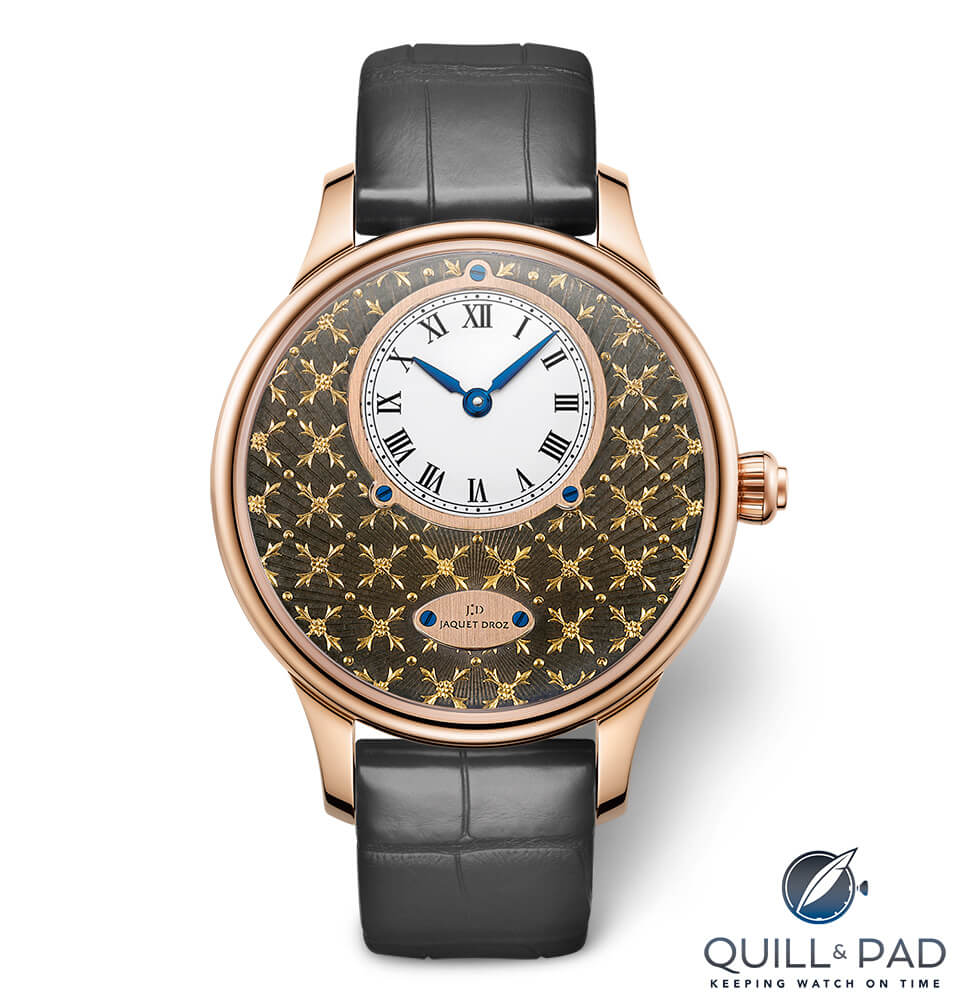
Jaquet Droz Petite Heure Minute Paillonnée
A particularly great case study of this idea is the Jaquet Droz Petite Heure Minute Paillonnée, a fantastic example of the craftsmanship found at Jaquet Droz and a style that might not fit everyone’s idea of an everyday watch, but one that many (including myself) would love to admire on a daily basis.
The Petite Heure Minute Paillonnée showcases a style rarely found in watches today and it proves that style is almost always an individual decision.
Unique style of the Jaquet Droz Petite Heure Minute Paillonnée
The Petite Heure Minute Paillonnée makes use of extremely traditional techniques to fly in the face of modern design directives. Jaquet Droz has a history of preserving traditional techniques, whether mechanical wizardry or métiers d’art; it is a brand that seems to march to its own beat style-wise.
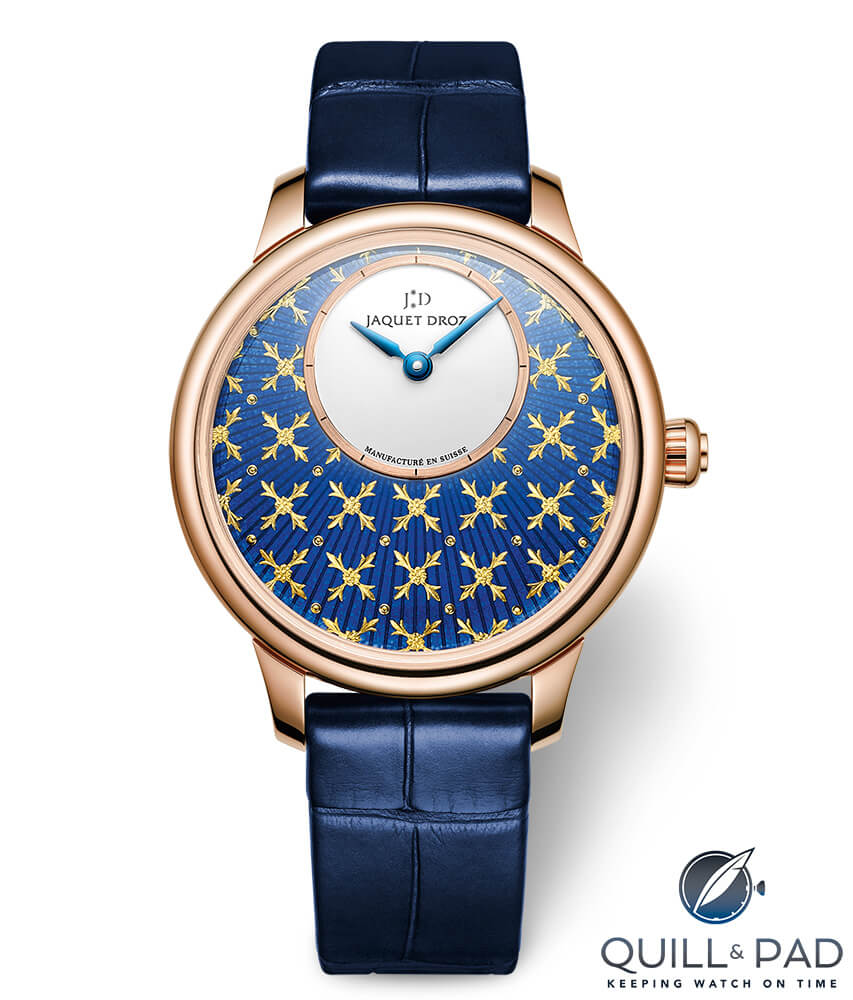
Jaquet Droz Petite Hour Minute Paillonnée
Its watches feel cohesive to the brand, but a bit separate from the direction most brands are going. They are unique watches for unique people.
Yes, there are unique watches by other brands, but Jaquet Droz goes in a direction that most others avoid: clean and refined elegance with a hint of artistic freedom.
People who wear Jaquet Droz usually aren’t the types wanting to brag about owning something from brand “X” or that rave to their friends about their time at the opera and their box seats. No, they go to the opera because they love it and the joy it brings them. And they wear a watch for the same reason.
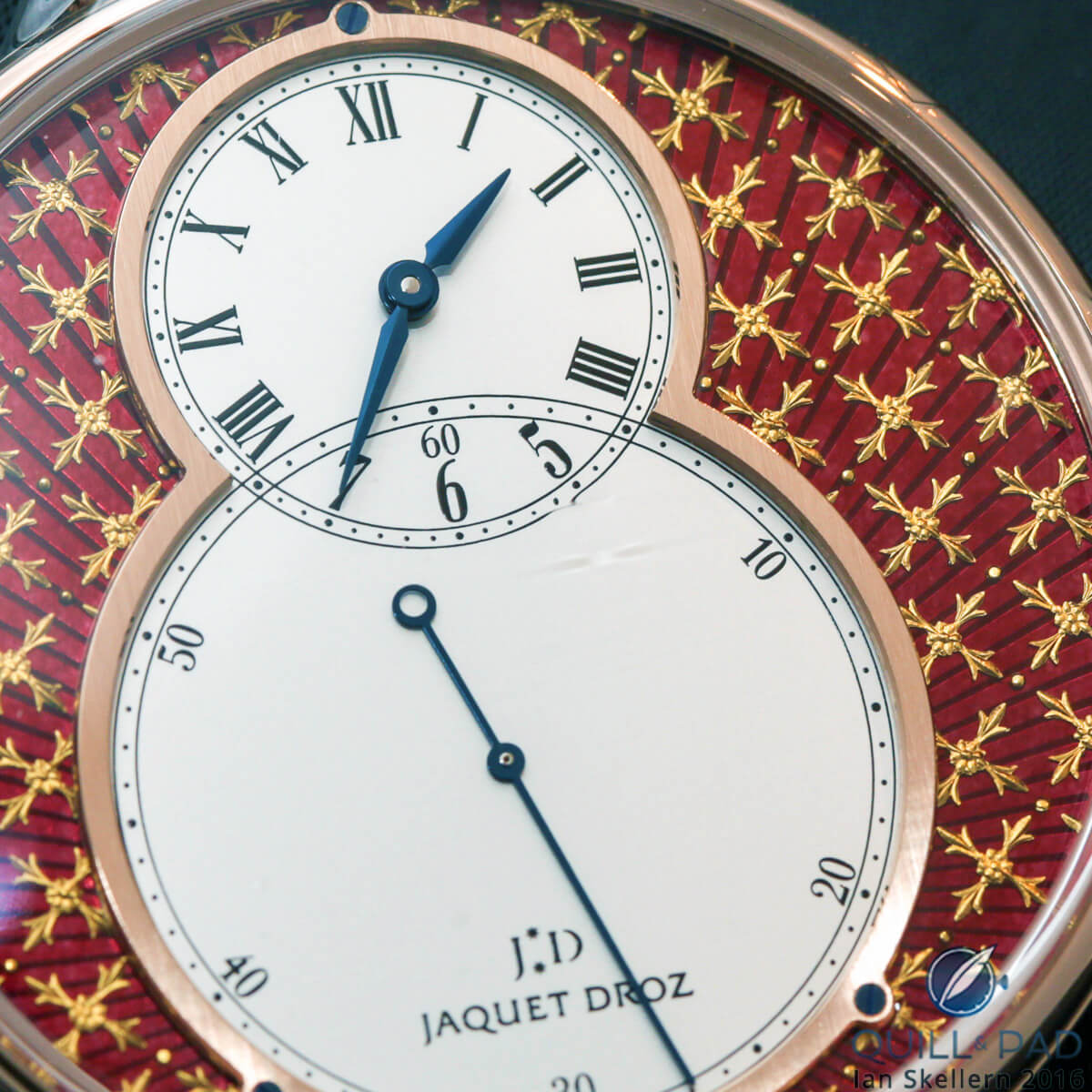
Jaquet Droz Pocket Watch Paillonnée
The Paillonnée technique is an extremely difficult enamel process producing incredible results in a very traditional style. The technique is so difficult that very few brands take the time to create watches with this technique, yet for Jaquet Droz it represents what the brand is about: skill, craft, and tradition.
People who would wear this piece understand that and yearn to own a piece of art – and by extension, share in an artist’s life story. A wearer of this style is more likely to be a patron of the arts than just a consumer of style.
The most difficult enamel process ever? Maybe
The delicate decoration of the Paillonnée technique is beautiful, of course, but its beauty belies its technical creation and the skill that goes into it.
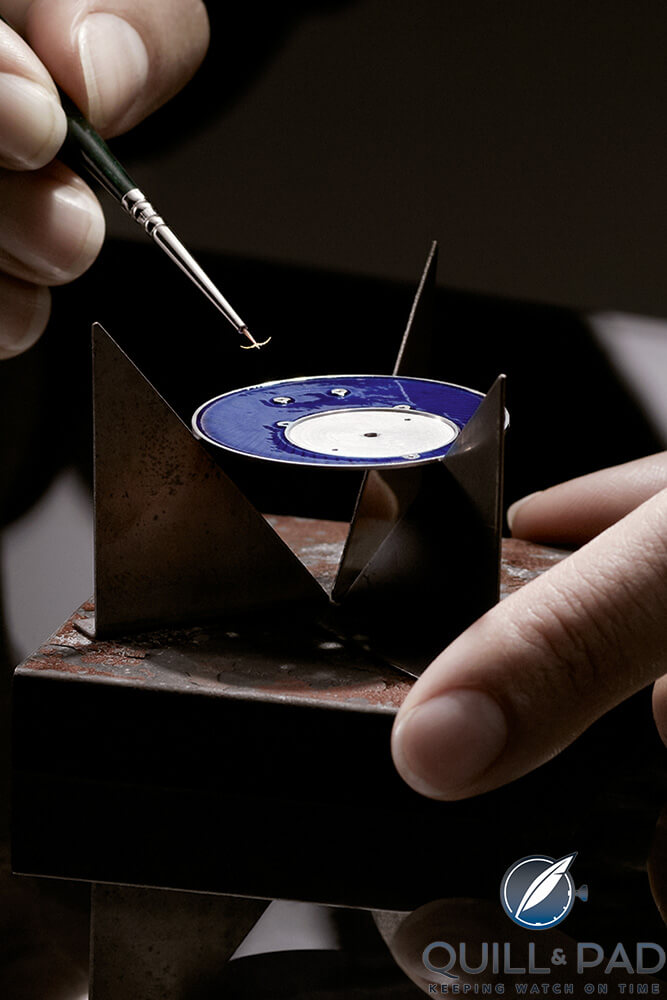
Delicately making a Jaquet Droz paillonnée dial
In this example, it first begins with a dial “finished” with guilloché engraving upon which a base layer of colored enamel is applied. This layer is then fired to create a translucent base that will hold the delicate paillons, these are delicate leafs of metal – gold in this case – cut from a very thin foil.
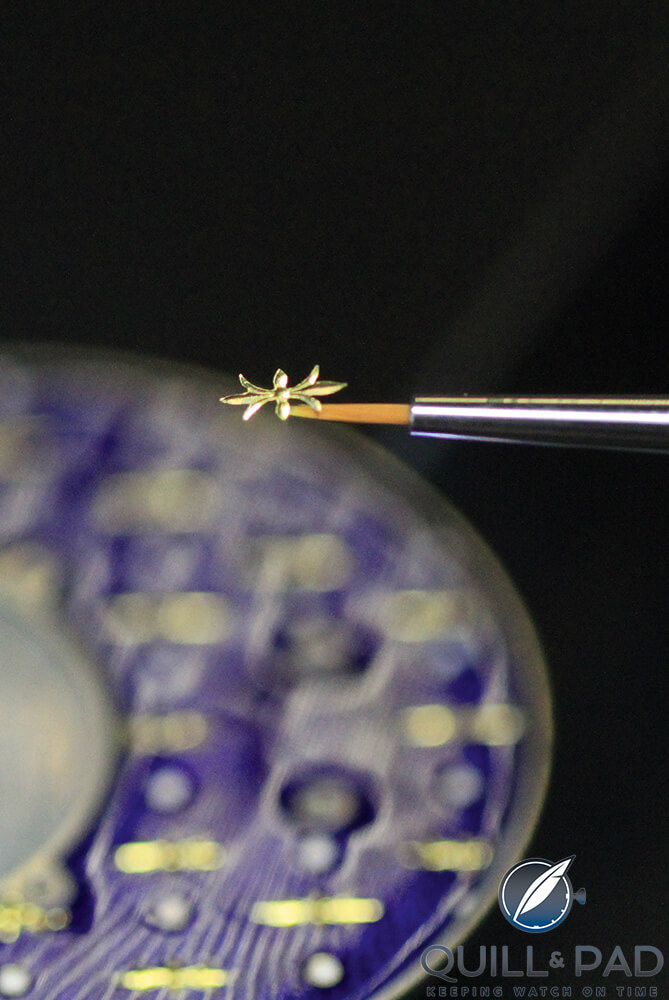
A sculptured single gold paillonnée being placed on the Jaquet Droz dial
The foil used here is thicker than standard gold leaf (which is a mind-bogglingly thin 0.1 micron or 1/10,000 of a millimeter) and stamped with a specially shaped tool to create the tiny shapes and sometimes micro textures.
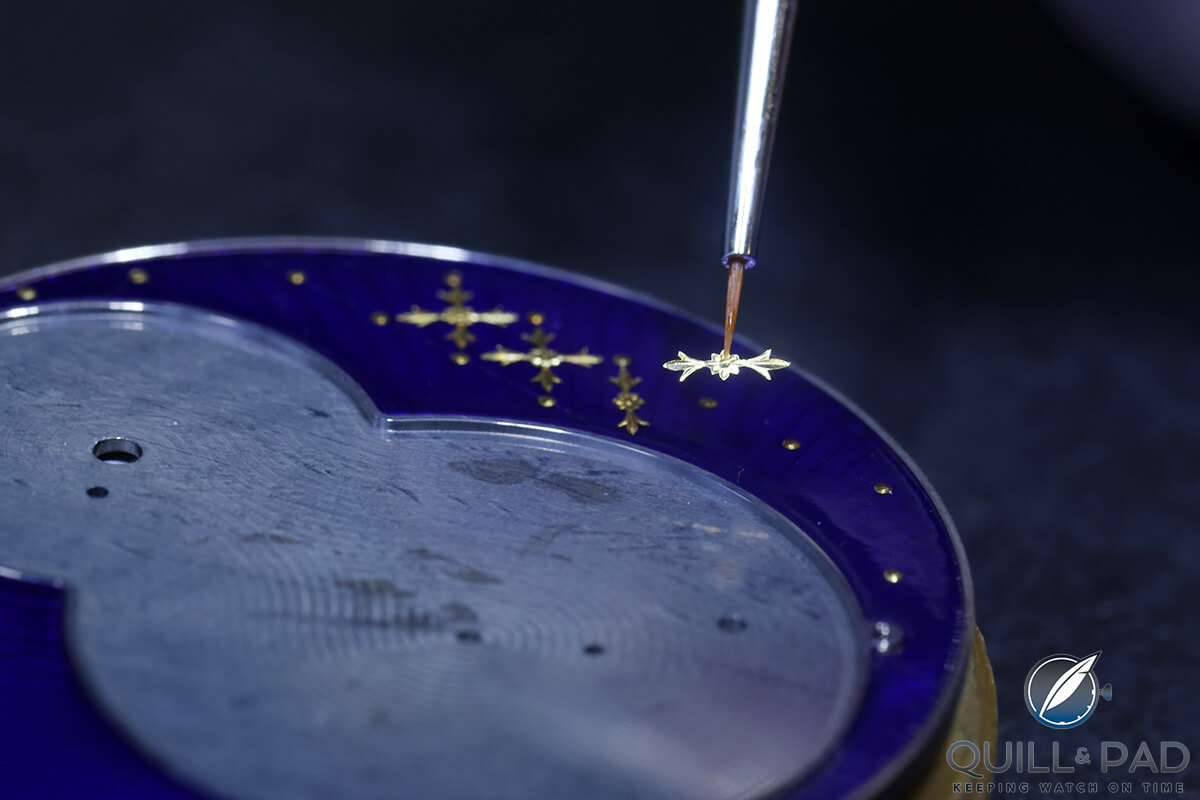
Applying a single gold paillonnée to a Jaquet Droz dial
The paillons are then very carefully placed, one at a time with a brush, onto the previously fired base enamel. The design must be very accurately arranged by hand before firing again to lock the pieces into the enamel.
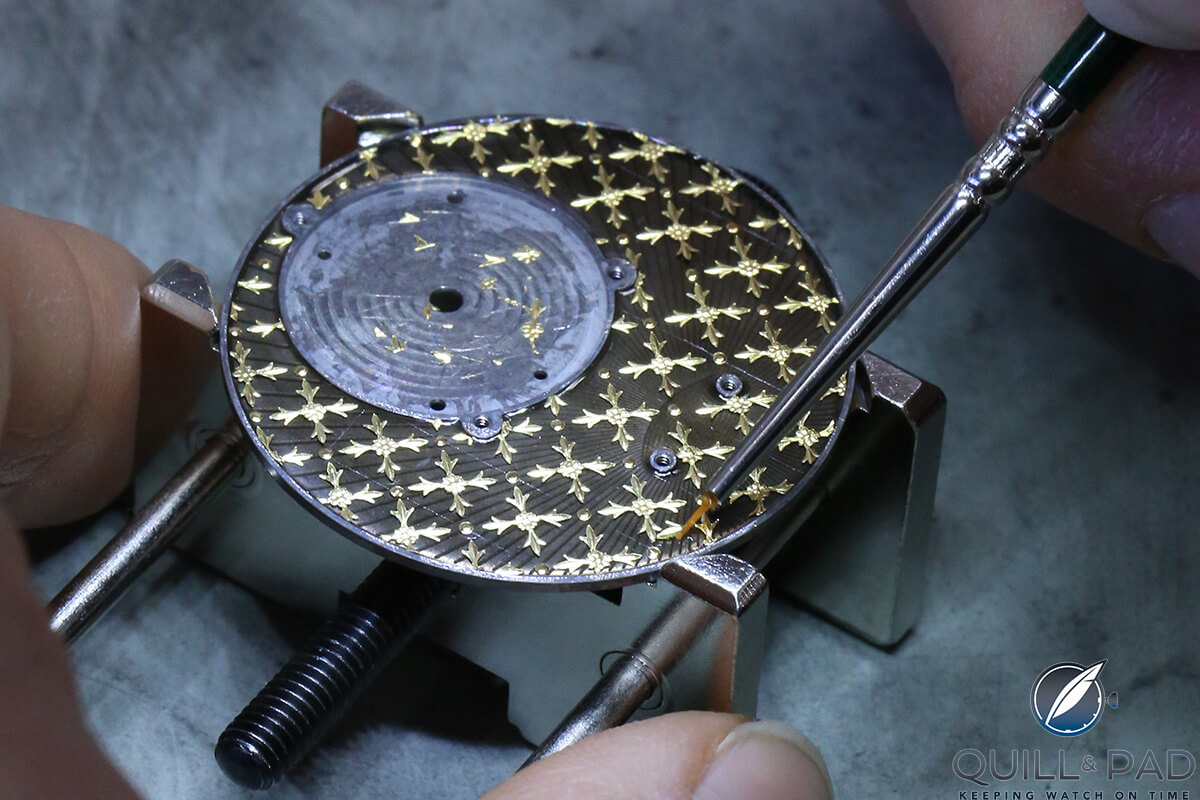
Making a Jaquet Droz paillonnée dial
Then, depending on the design, more translucent colored enamel is added to some of the paillons, and a final top coat of clear enamel is added to finish the dial into a cohesive piece and give it depth.
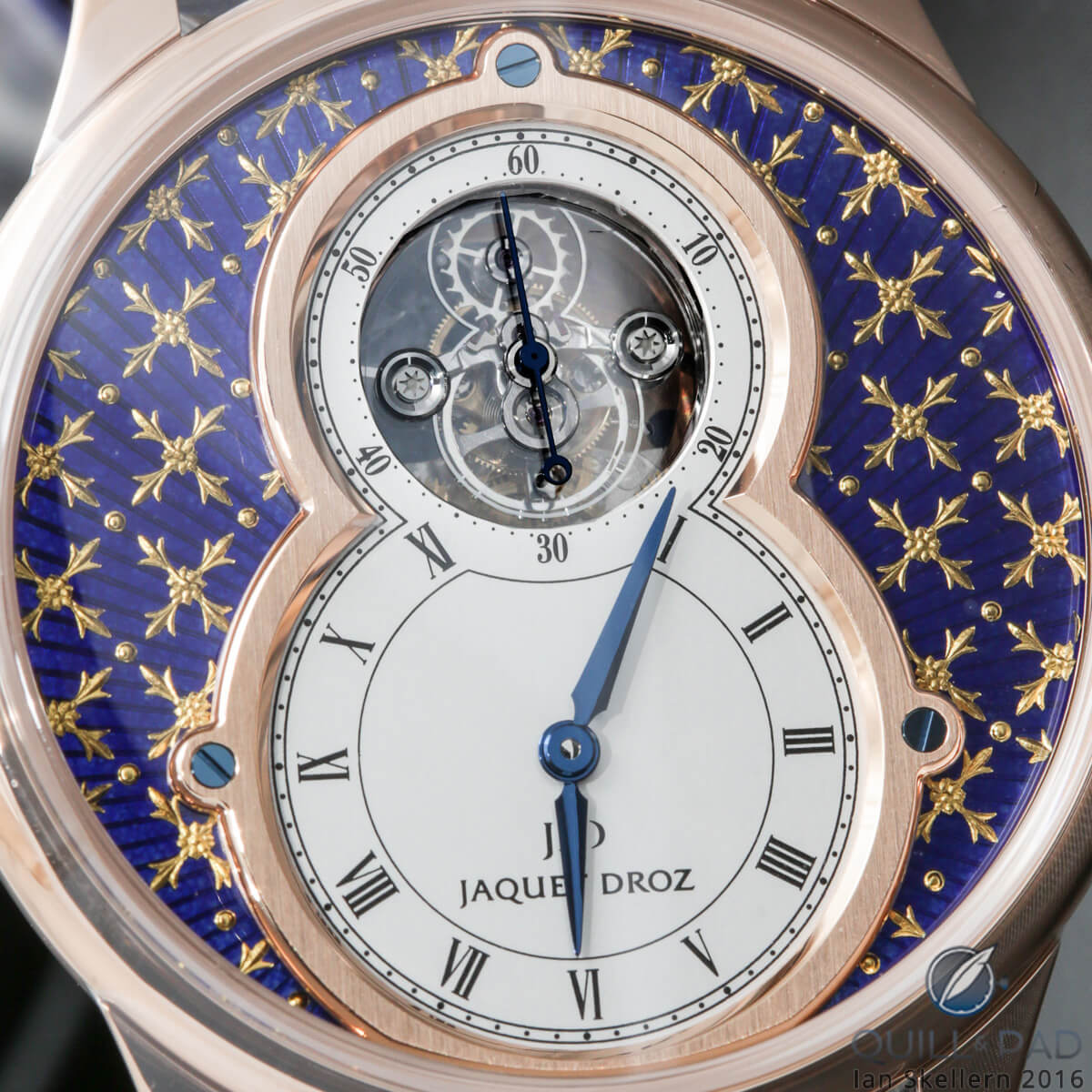
A close look at the dial of the Jaquet Droz Petite Hour Minute Tourbillon Paillonnée
This method is very slow and can take dozens of firings and as many layers to complete. But once it is done the dial radiates with sparkles of gold and the glowing translucency of the colored enamel.
The patience required for this technique borders on inhuman, but the results are well worth the effort.
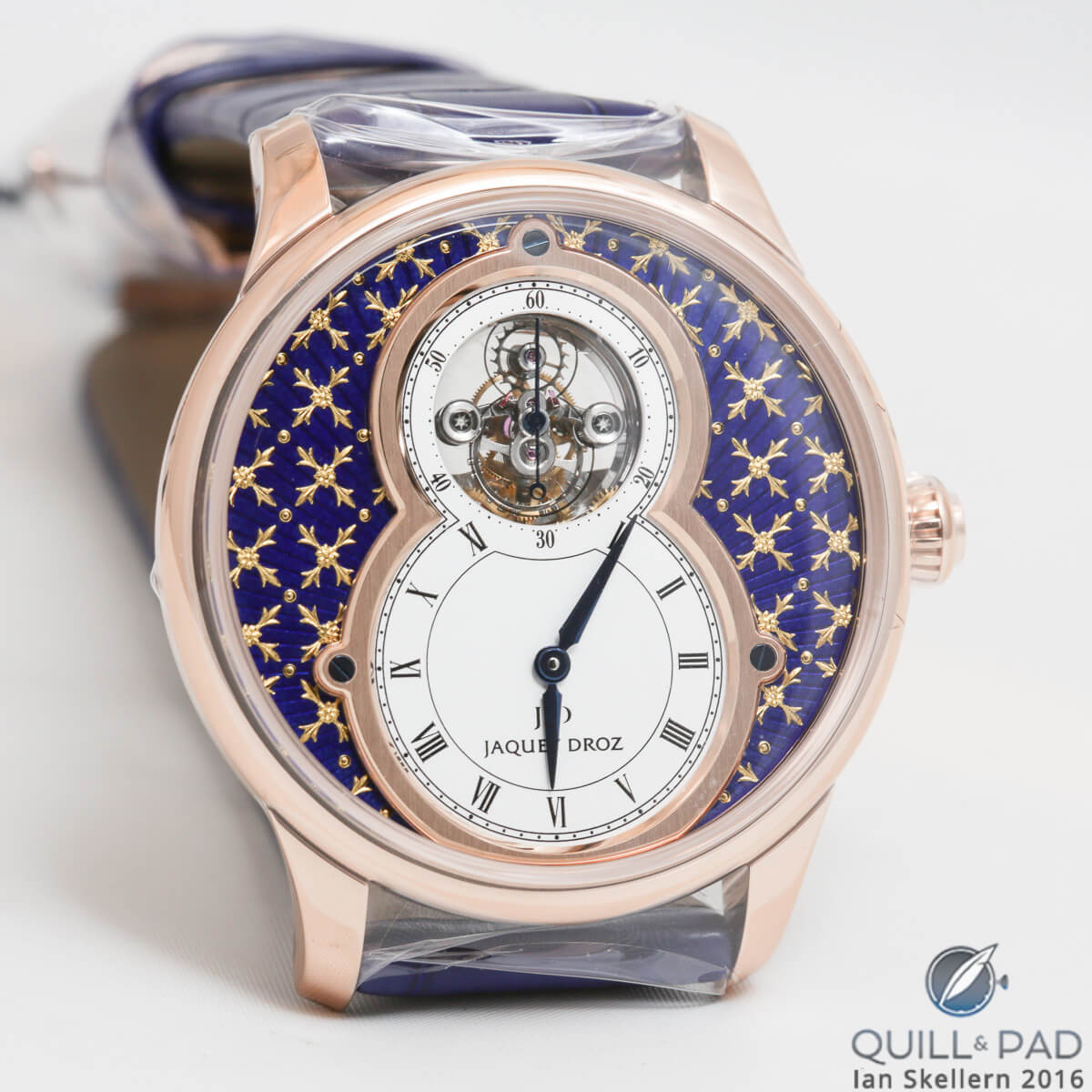
Jaquet Droz Petite Hour Minute Tourbillon Paillonnée
The delicate designs locked into the enamel are gorgeous and mimic decorative patterns seen in woodworking, tapestries, pottery, printing, and countless other instances throughout history.
Without Jaquet Droz investing the time and effort to see these pieces created, the technique might have been relegated to history as well.
Dress watch or a watch to be worn in any dress?
The Jaquet Droz Petite Heure Minute Paillonnée has a sartorial quality to it and wears like a flamboyant silk scarf or unique pair of socks. But like those clothing accessories, there are no hard rules about when or where you shouldn’t wear them because in fashion, everything is relative.
There are those old fashion rules like no white after Labor Day but, digging a little deeper, it turns out that rule was created largely as a classist delineator to separate the haughty “old money” from the vulgar “new money.”
As such, most rules for dress are kept in place by people who feel the need to hold on to an outmoded status quo. Because, you know, if someone disagrees with them, that person must be so . . . uncouth.
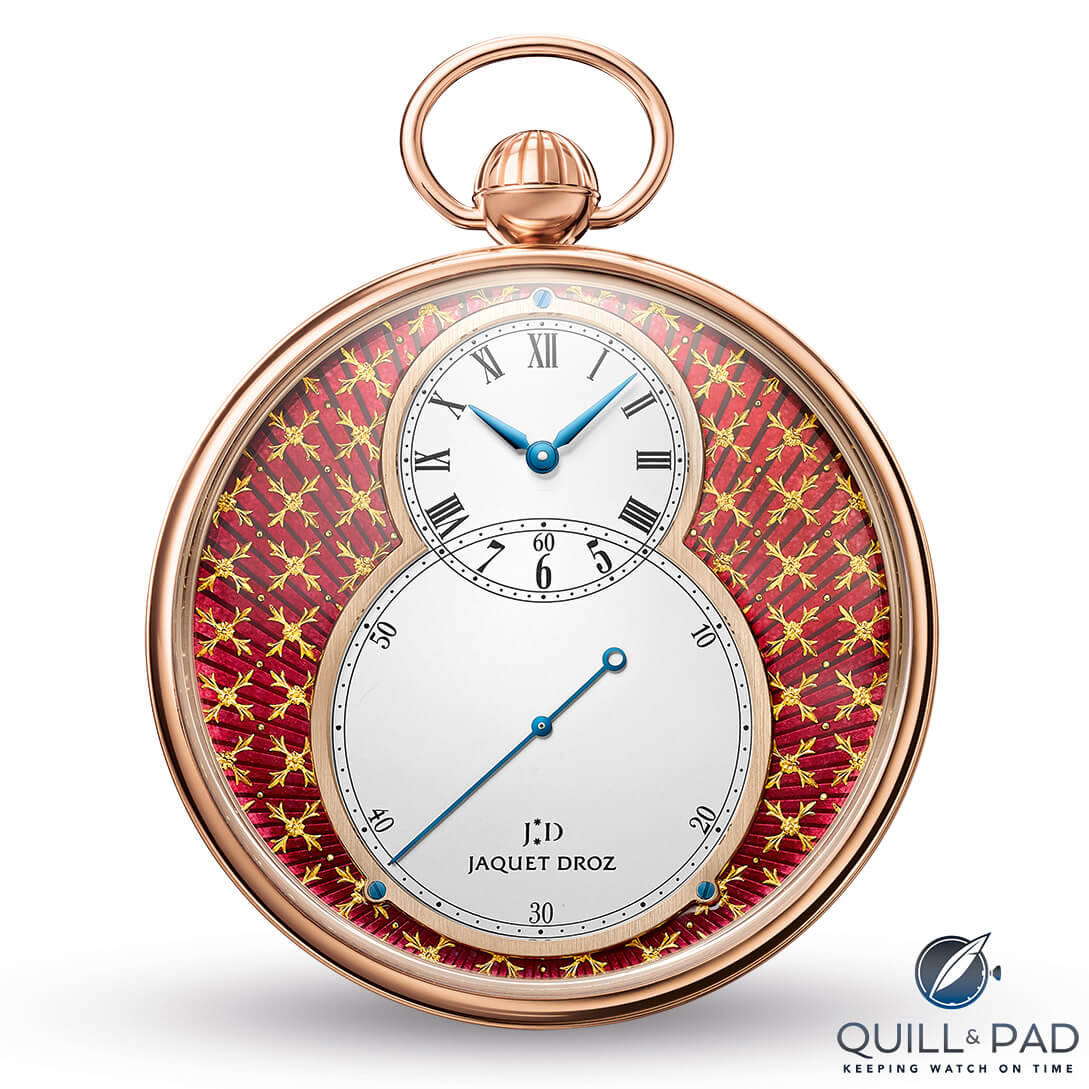
Jaquet Droz Pocket Watch Paillonnée
But getting past what others think (seriously, it’s a main key to happiness, let me tell ya), wearing delicate and beautiful watches bordering on art is a bold move in pretty much any context.
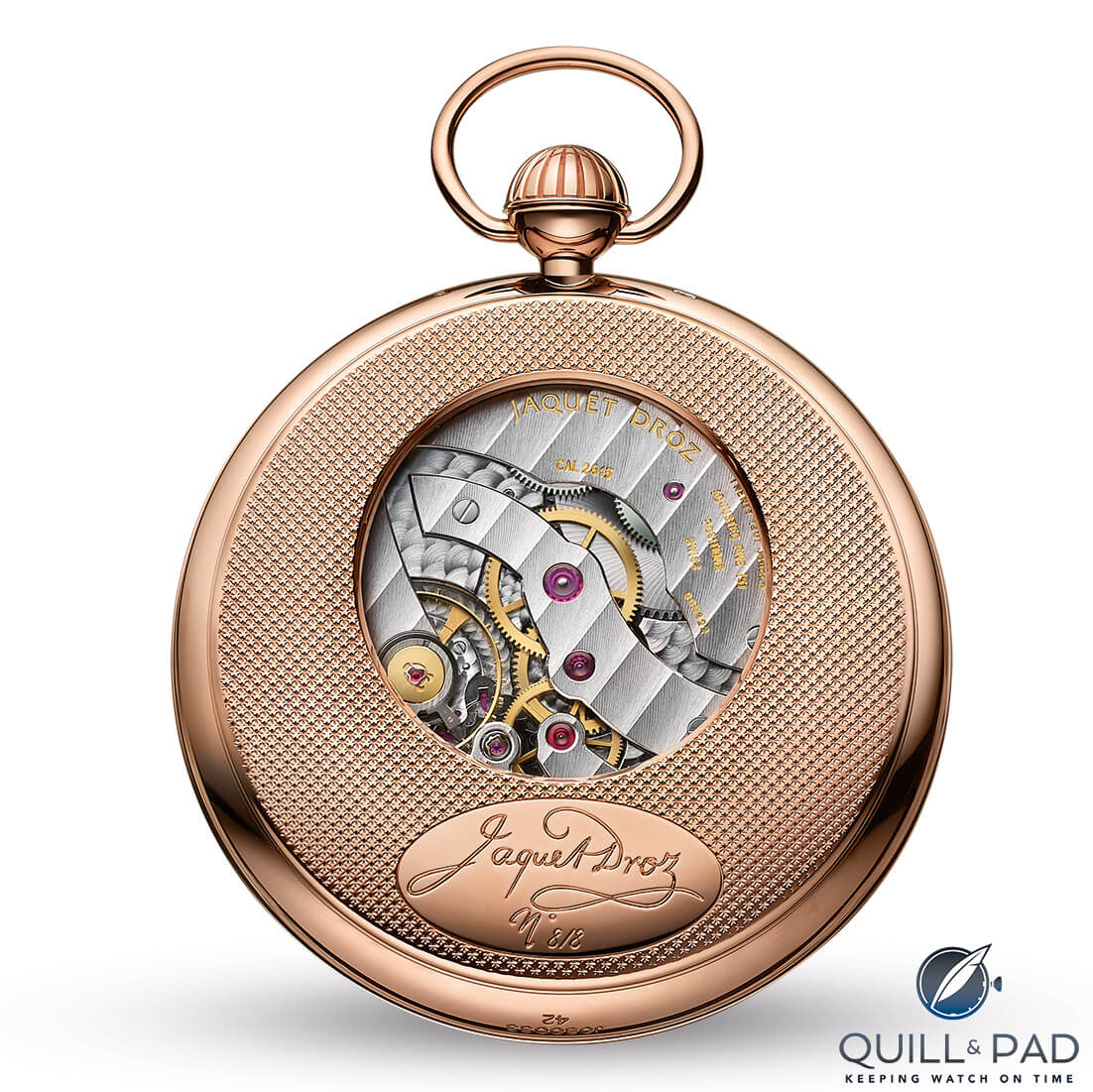
View from the back of the Jaquet Droz Pocket Watch Paillonnée
It’s like wearing a large patterned plaid suit. Unless you live in Scotland (and perhaps even then . . . ), you are going to stand out, and to many people, not in a good way. But those choosing to wear the plaid suit probably don’t care either, because they know they look good in it and enjoy the style. The rest of the world can go quietly into that good night.
The Petite Heure Minute Paillonnée is a collection of stunning patterns and classic design. It is something that would look at home in a museum, or at the opera, or framed on your wall at home. But it yearns to live on your wrist, and that is exactly where it belongs. It would be a tragedy to only wear it to the grandest events a couple evenings a year and not every time the sun is shining.
I imagine that with a different style of dial, this watch would surely fall into the category of a daily wear piece for many people. It’s a perfectly sized 39 millimeters in diameter and under 12 millimeters thick, making it slim enough to comfortably fit under the cuff.
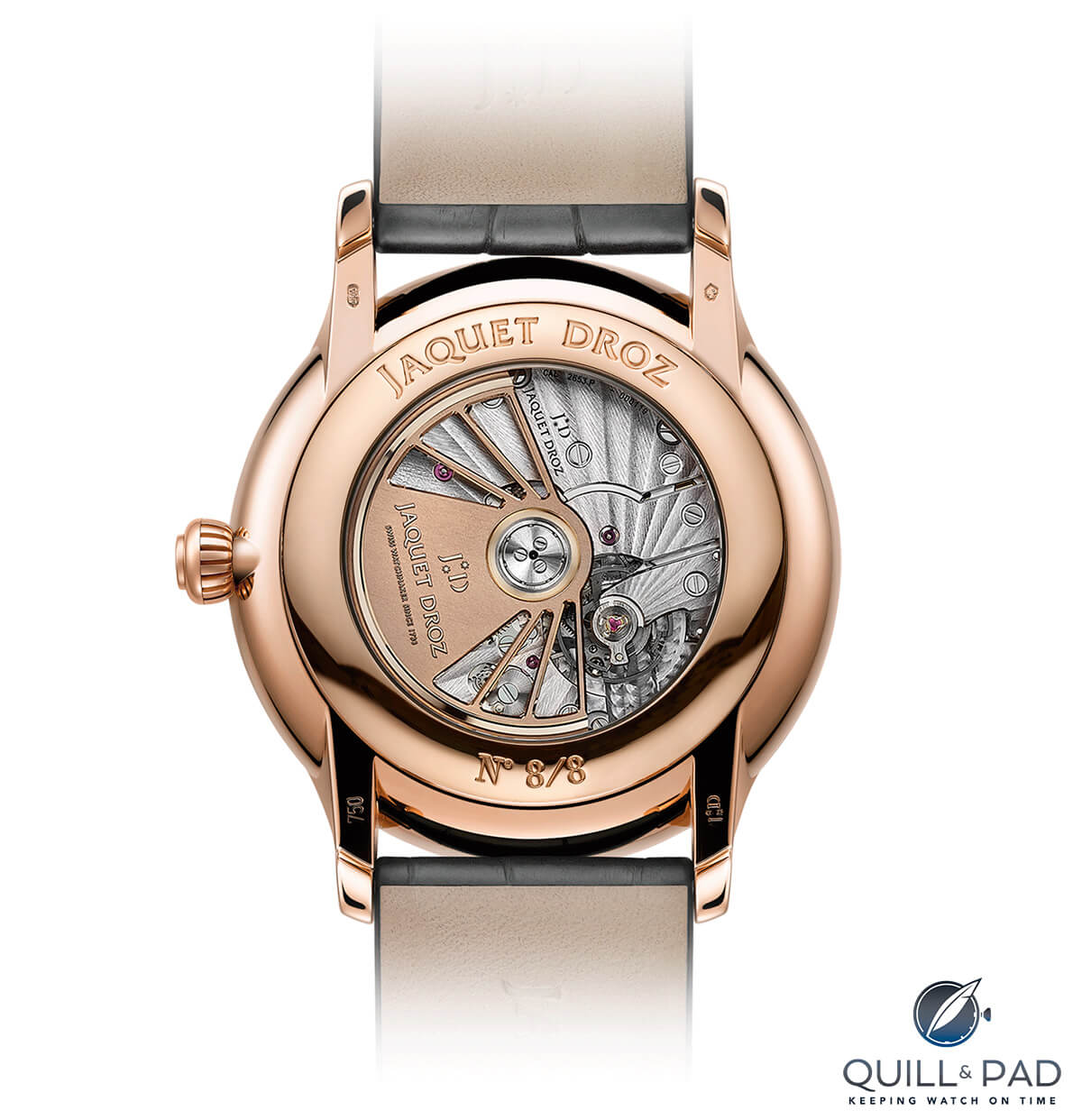
View through the display back of the Jaquet Droz Petite Heure Minute Paillonnée
It is powered by the great Caliber 2653.4, a descendant of the historic Frédéric Piguet 1185, a stout self-winding movement with 68 hours of power reserve. It really is just a great watch, while being a watch that also happens to be artistically exuberant.
It will come as no surprise to most that I love Jaquet Droz as I’ve written about a few of its pieces in the past (see Jaquet Droz Grande Seconde Off-Centered: A Paragon Of Tranquility, for example).
And with the variety of watches and styles I have proclaimed to adore over the past few years, this one fits right in with a smorgasbord of artistic creations. But the most important fact is that this watch deserves to be seen every day.
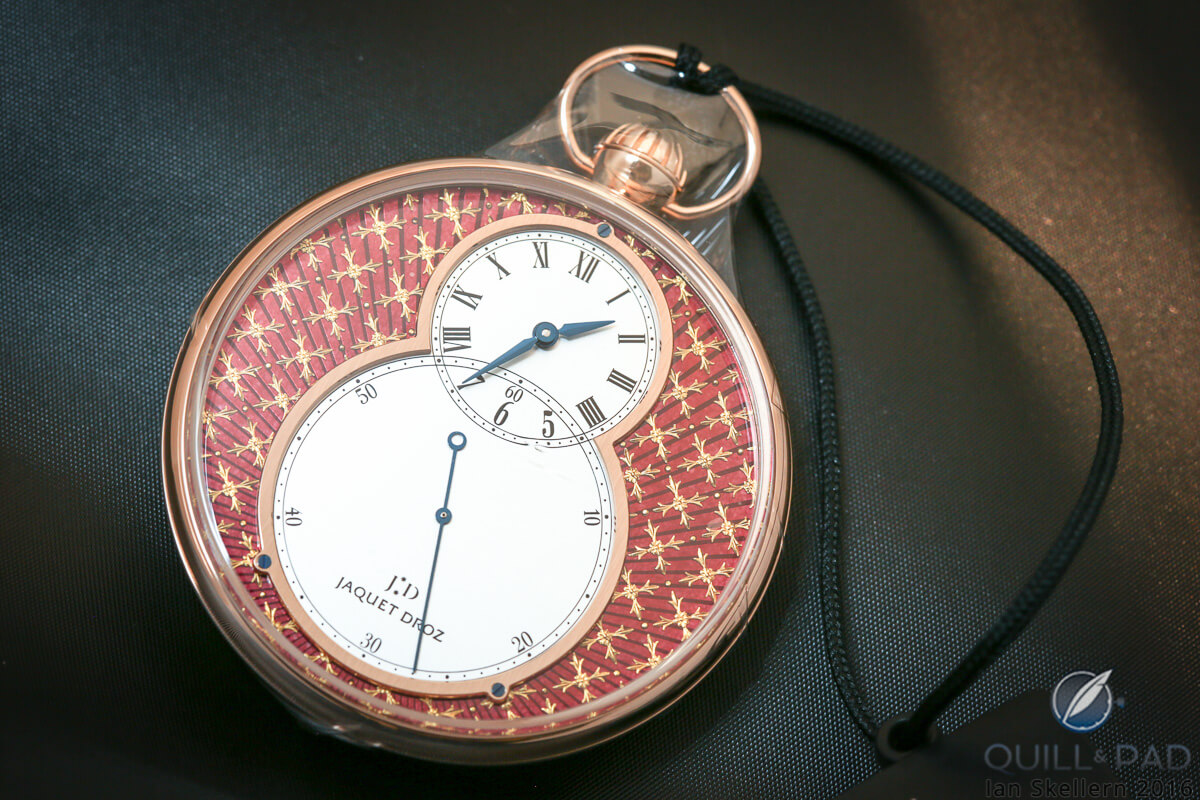
Jaquet Droz Pocket Watch Paillonnée
The time and talent that went into its creation beg for an audience to marvel at its beauty. If it were to become a “safe queen,” barely finding itself on a wrist, that would be a tragedy of horological proportions.
So I guess I am proposing that the Petite Heure Minute Paillonnée is not a dress watch. It is fancy and beautiful, yes, but it is not just a simple watch to complement the slim tuxedo in your closet once a year.
This watch is a bold everyday watch, with a style that the owner will wear proudly and repeatedly so as to properly appreciate its incredibleness. It is a timepiece that deserves your time and your attention, not that of the crowd.
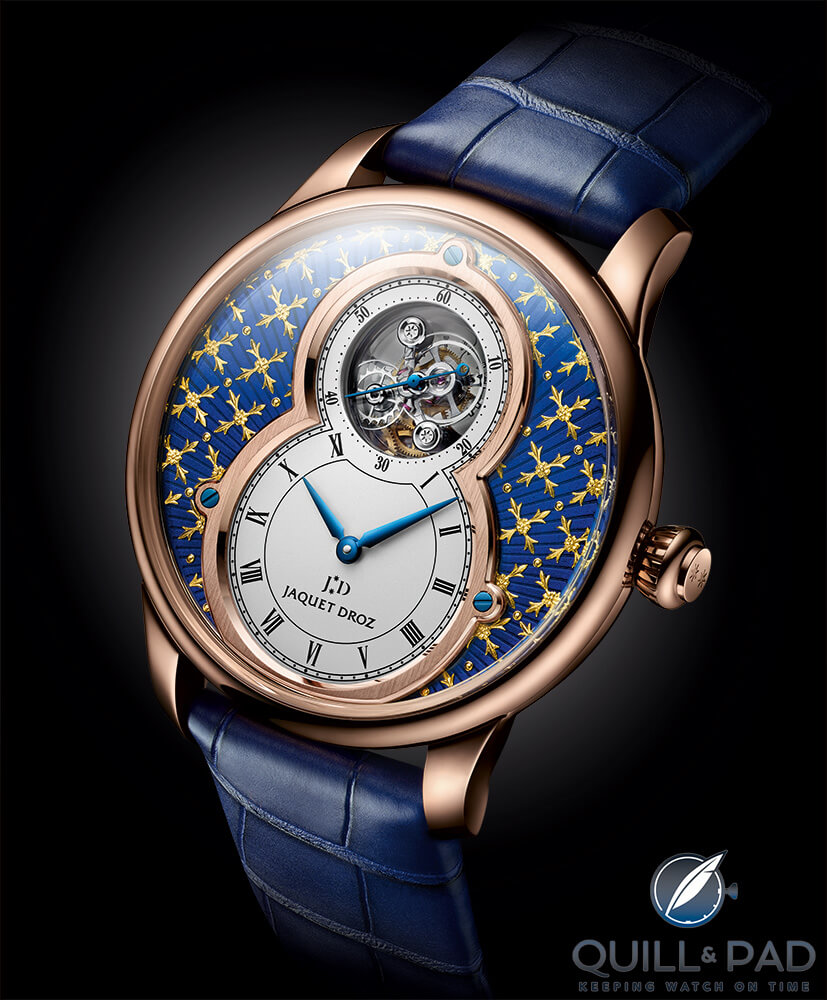
Jaquet Droz Petite Hour Minute Tourbillon Paillonnée
The crowd doesn’t know what is right for you, and the crowd can’t make up its mind anyway. If you like it then by all means wear it, rock it, and embrace it. The people behind the Petite Heure Minute Paillonnée poured their hearts and souls into it, and the least you can do to repay that is to appreciate it as often as possible.
I know I would.
While I wait for it to grace my collection, we’ll have to live with the breakdown!
- Wowza Factor * 9.81 I think one need only glance at the dial to understand why these pieces wow so darn much.
- Late Night Lust Appeal * 110.01 » 1,078.829 m/s2 Slowly gazing over the tiny paillons made from tiny sheets of gold carefully laid into shimmering enamel is enough to make me lust well into the wee hours.
- M.G.R. * 48.5 It’s a solid geek rating for a high-quality and well-finished movement.
- Added-Functionitis * N/A Like what happens often, some of the coolest pieces don’t need to complicate things to make their way onto my want list. Still you can skip the Gotta-HAVE-That cream and just gaze at the classic beauty.
- Ouch Outline * 10.1 Burning yourself on a Hanukah candle! There are many holiday traditions in the mix where I live, and sometimes caution needs to be observed. Yet I wouldn’t hesitate to play with fire if it meant this puppy showing up with a bow on it!
- Mermaid Moment * Look at that enamel pattern! Observed skill has a way of making someone passionate about things, and seeing how the paillonnée craft is accomplished makes me certain that I need to go ring shopping.
- Awesome Total * 936 Multiply the diameter in millimeters (39) to the water resistance in bar (3), and then multiply the result by the number in each of the limited editions (8) for a classically skillful awesome total!
For more information, please visit www.jaquet-droz.com/en/watches/les-ateliers-d-art/petite-heure-minute-paillonnee.
Quick Facts
Case: 39 x 11.52 mm, red gold
Movement: automatic Caliber 2653.P with silicon balance spring and pallet fork, twin spring barrels
Functions: hours, minutes
Limitation: 8 of each design
Price: $42,000

Leave a Reply
Want to join the discussion?Feel free to contribute!